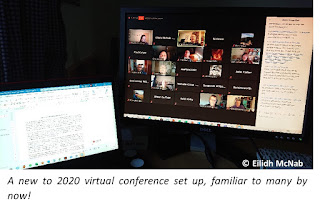Blog by Kieran O’Malley
These
unusual times call for an unusual symposium, so instead of crowding into a room
I found myself crowding into a zoom call for the Bat Conservation Trust’s
second woodland symposium.
The symposium
was a two day event that brought together a variety of stakeholders, from bat
workers and researchers to landowners and managers. Being a PhD student that carries
out research on a woodland specialist species (the barbastelle bat), I was
excited to engross myself in a community of like-minded individuals who all
share a common goal; to restore and improve our native woodland, particularly
for bats.
Unfortunately, I was unable to attend the
first day of the event due to other commitments (thankfully I will be able to watch
a recording of it at a later time). However, the second day provided plenty of intriguing
talks and topics to make up for this! The day kicked off with a talk from Ash
Murray, a senior reserves manager for Natural England, who presented some interesting
results of how bats use woodlands, not just at ground level but also within the
often overlooked canopy.
Shortly after this Vikki Bengtsson (Pro
Natura) gave a fascinating talk on veteranisation, a process in which cavities
are artificially created within trees or stimulated to form by the damaging of live
young trees. Given my interest in barbastelles, which often rely on the large number
of cavities associated with ancient trees, I found the findings from her work
particularly enthralling. It was the first time, perhaps naively, that I had
heard of this method of woodland management. However, I quickly came to
appreciate that the implications of this work could be potentially far-reaching.
After a short break, we joined a Q&A session
with a panel of experts to discuss climate change and conservation. This was a
great chance to explore the challenges facing bats, as well as other species, and
highlight the actions that need to be taken moving forward. Whilst the many
difficulties of the situation were discussed, it was encouraging to hear the
optimism from many of our panellists. As Dr Olly Watts, senior climate change
policy officer at the RSPB, said “we do finally seem to be moving economic and
social life’s towards a way of better green living”, and I think we can take
some hope from this. In fact, as was discussed, bats in the UK will fair proportionally
well compared to many parts of Europe, with species expanding their range north
whilst still retaining their southern populations.
After a break for lunch, George Peterken
provided the keynote talk on the long term study of Lady Park Wood on the
border of Gloucestershire and Monmouthshire. With the recording of trees at
this site starting as early as 1944, it was incredible to hear about the history
of this woodland, along with all the ups and downs that have occurred over the
years. In particular, I was impressed to learn of the dedication of George and
others in the creation of detailed maps that documented the exact position and
size of individual trees within the woodland.
I thoroughly enjoyed the symposium, and
learned a great deal about the different projects happening across the UK and
beyond. Despite having to juggle over 150 participants over zoom, with all the
breakout rooms and questions to answer, the symposium was both smoothly run and
engaging. I send out my huge thank you to all the organisers and speakers, and I
look forward to seeing everyone again at the next one, hopefully this time in
person!
Click here to
listen to the Woodland Symposium episode of BCT's BatChat podcast, to find out
more about the 2020 Woodland Symposium!












